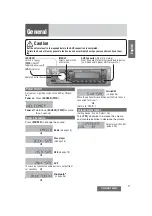
Introduction to the Basic Encoder
Page 1-10
Reference Guide: EN8000 MPEG-4 Part 10 (H.264/AVC) Encoders
ST.RE.E10233.1
1.4.3 Audio
Encoding
The available audio algorithms that can be used to encode the input audio are:
AAC (MPEG-2 and MPEG-4)
The encoder has the capability of encoding incoming audio using the highly efficient Advanced
Audio Coding (AAC) algorithm. This is the standard WindowsMedia audio algorithm for WM9S
and is commonly known as WMA in the public domain. The sampling rate is restricted to 48
kHz and the constant bitrate can be varied between 64 kbit/s and 128 kbit/s for a stereo pair of
audio channels.
There is only a single encoding algorithm but there is a menu switches to allow one of main
variants to be selected:
•
MPEG-2 AAC: the actual AAC bitstream is compliant to the specification ISO/IEC 13818-7
and is encapsulated in ADTS (Audio Data Transport Stream), which is described in the
same specification. Menu switches have been included to allow the operator to enable an
ARIB-compliant mode.
•
MPEG-4 HE-AAC: the actual AAC bitstream is compliant to the High-Efficiency (HE) AAC
profile of MPEG-4 Part 3 as described in ISO/IEC 14496-3. This allows the use of the
Spectral Band Replication (SBR) tool to achieve reasonable results for sub-64 kbit/s
stereo encoding. The minimum bitrate has been restricted so that operation of the encoder
does not use any of the extra tools associated with version 2 of the Profile. The bitstream
is encapsulated in the Transport Stream using LATM/LOAS (Low-overhead Audio
Transport Multiplex/Low-overhead Audio Stream). The implementation is compliant to
ETSI TS 101 154 V1.7.1 Annex H.
•
MPEG-4 HE-AAC v2: The actual AAC bitstream is compliant to the High Efficiency (HE)
AAC v2 profile as described in ISO/IEC 14496-3. This allows both Spectral Band
Replication (SBR) and Parametric Stereo (PS) tools to be used. Operation in this mode is
currently restricted to Stereo at 32 kbit/s.
MPEG-1 Layer II
The Encoder can encode incoming audio at a sampling rate of 48 kHz to an
MPEG-1 Layer II compliant bitstream for TS output only. The available coding modes are:
•
Single Mono: either the left or the right channel is encoded - the signal is output to both
XLR connectors at the receiving end. Not available in Linear PCM.
•
Dual Mono: the left and right signals are encoded and carried in the transport stream as a
single Packetised Elementary Stream (PES) data stream. The way that the left and right
signals are output from the Receiver is dependent on how the routing is set up on the
Receiver. Both the left and the right may be output, or the left only, or the right only. This is
typically used for multilingual services.
•
Stereo: A stereo pair is coded as two mono signals - the two signals are output as stereo
at the receiving end.
•
Joint Stereo: A stereo pair is coded taking advantage of the stereo nature of the channels
- the two signals are output as stereo at the receiving end. Available in MPEG-1 Layer II
only.
•
Audio Description Service: Signals the presence of an Audio Description Service for the
visually impaired in the PMT.
















































